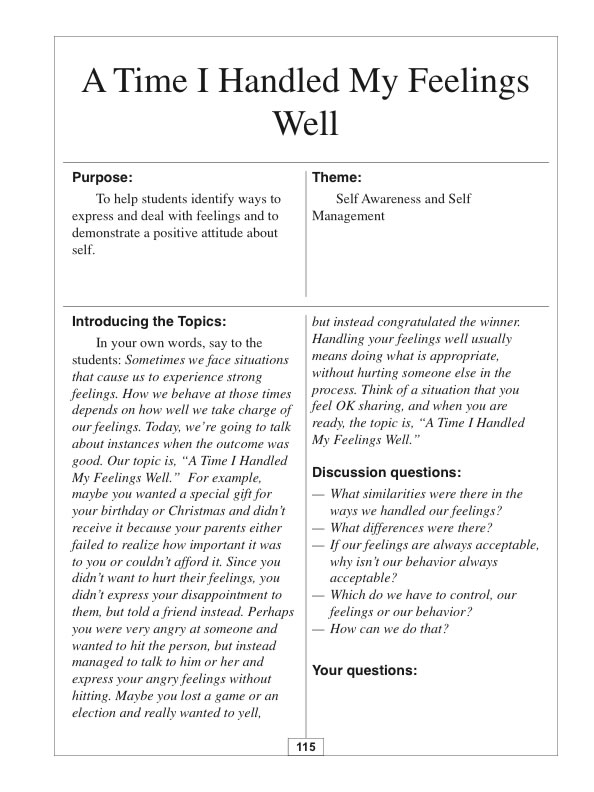Recognizing the Importance of Emotions and Feelings
Try this little exercise. On a blank sheet of paper draw a line down the center. Label the left side Feelings, and the right side Actions. On the left side, write a list of as many of the feelings you can remember that you’ve had today. Leave a few spaces between the words. You may think of a feeling you had in traffic getting to school, or a response to a student, etc. Take only a minute to write this list of feeling words.
Now move to the action side. Pick out one positive feeling you wrote, and opposite it in the action column, write what you remember you did in response to that feeling. You may have laughed, said thanks, etc.
Next, pick one feeling that was not pleasant and write down what you did.
Now, pick out the feeling that made you most uncomfortable and write down what you did.

Can you see how absolutely our actions are connected to our feelings? We all respond to our feelings, not in the exact same way, but we all do respond. Our feelings flow from our emotions. All people have the same emotions. Things like love, hate, fear, etc. The feelings people have as they experience these emotions can vary as can their behaviors in response to these feelings. Emotions generate our feelings, and our feelings are messages that tell us that we are experiencing an emotional event. It is what we do in response to these feeling messages that is a measure of our emotional intelligence.
The Impact of Emotional Intelligence
Because of their connection to behavior, emotions impact every area of life: health, learning, achievement, and relationships.
Managing feelings well and recognizing and responding effectively to the feelings of others enables students to lead happy and productive lives and to master habits of mind that contribute to personal and career success. We all, parents and educators, must nurture emotional intelligence in the same caring way we nurture IQ.
Think for a minute about the implications of this to what students need to learn – to what we need to teach. What a gift we give to students when we help them learn to channel their feelings into positive behaviors and developing self control.
Here Are Your Sharing Circle Lessons
Today’s Sharing Circle topics come from the K- 12 book, Guided Discussions for Developing Emotional Intelligence. Sharing Circles are a superb tool for helping students to identify, understand, and manage their feelings, and this book has over 100 Sharing Circle lessons. The topics are, Someone Who Respects My Feelings and A Time I Handled My Feelings Well.
 Here’s Your Monday Morning Sharing Circle. Enjoy!
Here’s Your Monday Morning Sharing Circle. Enjoy!
Do you want more information?
• Leading a Sharing Circle
• Sharing Circle Rules
• Books and Resources
• Free Activities
• Subscribe
Go here:
Here’s How It’s Done
Gather everyone into a circle. Explain the rules for sharing, and get agreement from everyone that they will follow the rules.
Sharing Circle Rules:
- Everyone gets a turn to share, including the leader.
- You can skip your turn if you wish.
- Listen to the person who is sharing.
- There are no interruptions, probing, put-downs, or gossip.
- Share the time equally.
After everyone has shared, who wants to share, ask the discussion questions.
You can check the book out HERE.
Just click HERE to open a fully reproducible PDF of this activity and experience sheet…
If you like our blog resources and would like to receive them regularly, please subscribe here or on our website at www.InnerchoicePublishing.com
If you are already a subscriber, I hope you find this activity valuable. Help us grow our blog by sharing these activities and encouraging others to join. Thank you.
Thanks so much for reading!
Susanna


